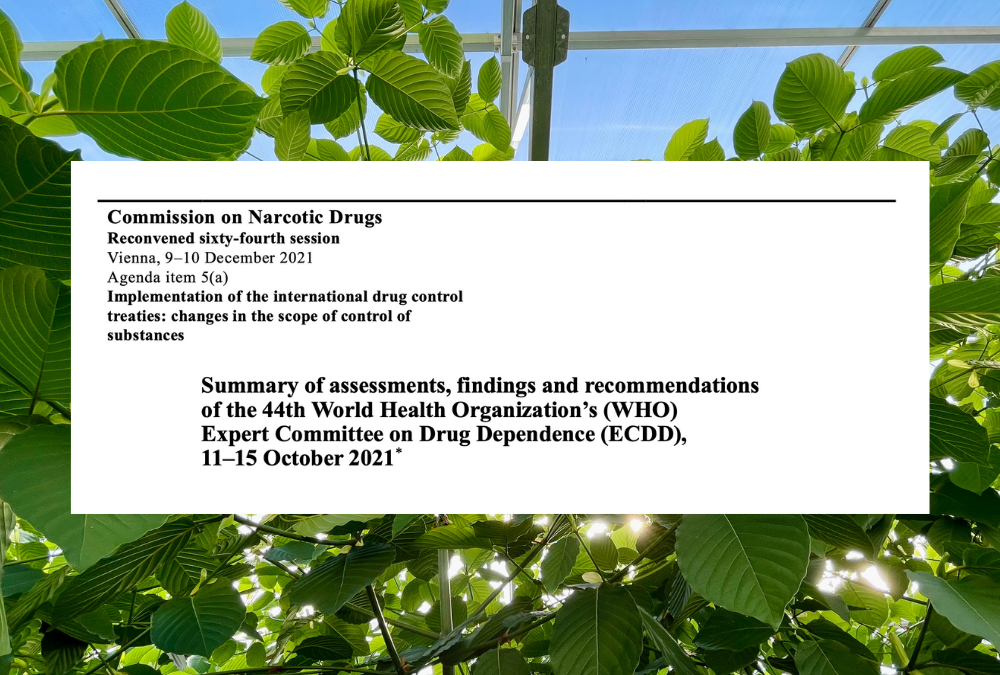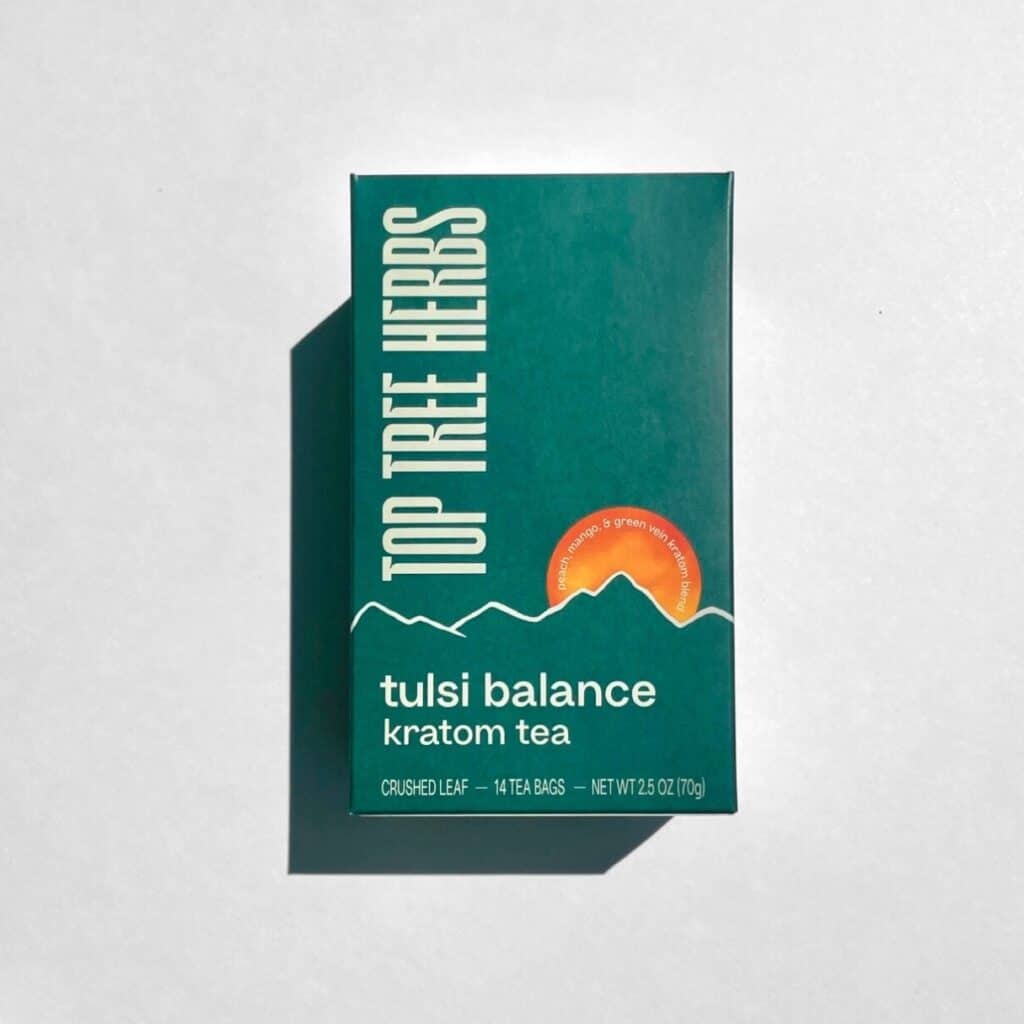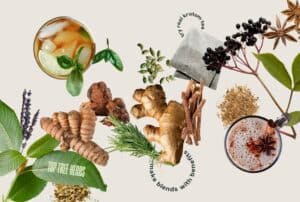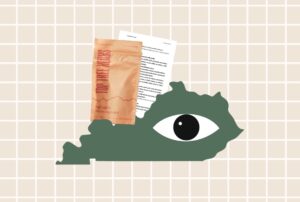Expert Committee on Drug Dependency Considered Kratom Ban
The UN Expert Committee on Drug Dependence (ECDD) regularly convienes to discuss a list of substances presented to them. Usually, their convention comes and goes without much fanfare. However, this time was different. The ECDD had listed kratom as a substance of concern. They specified two of its many active alkaloids, mitragynine and 7-OH-mitragynine, as well. In short, they were deliberating on whether to impose a global kratom ban.
UN and WHO Kratom Control
Historically, the ECDD lists substances that they plan to schedule publicly and that is that. Those that do not wish to see prohibition perpetuated were largely pessimistic about convincing the ECDD to not recommend scheduling.
Many were under the impression that the inertia behind the UN or the WHO was simply impossible to change course. As such, activists watched the ECDD convene with the feeling that their hands were tied behind their backs.
2021 Kratom Ban Timeline
In July of 2021, the FDA announced that kratom would be considered by the ECDD for scheduling. Kratom users prepared to stand their ground. First, the FDA collected comments to submit with their recommendation for scheduling to the UN.
In response, 80,000 people left overwhelmingly positive comments. The American Kratom Association (AKA), a kratom consumer advocacy group, collected a similar amount of positive comments to compliment those submitted to the FDA.
When the official hearing occurred, the most highly regarded scientists studying kratom presented their findings to the hearing. Those scientists who argued for kratom include Dr. Christopher McCurdy, Dr. Fabian Steinmetz, Dr. Jack Henningfield, among many others.
Simply put, there was an overwhelming amount of evidence suggesting that kratom has a low risk profile when used responsibly. They recognized that more data is needed, but thankfully a lot of research has been done in recent years substantiating kratom’s efficacy.
Plus, they had precedent: even top regulators in the US say banning it would cause significant social harm to those who use it in place of dangerous substances. In essence, kratom advocates made the classic anti-prohibitionist argument.
This time, the above average safety record of kratom bolstered the anti-prohibitionist argument. Yet, if you asked anyone in the know whether the ECDD would follow the science, the resounding answer was “it could go both ways.”
Why We Expected the Worst Kratom Ban
These hesitant reactions were the result of an understanding of the history of prohibition. From the get go, certain social groups leveraged prohibition for their own gain.
As an example, Harry Anslinger, the US’s first “drug czar” was originally in charge of enforcing alcohol prohibition. Anslinger worried he, and the hundreds of men who served under him, would be unemployed as alcohol prohibition waned in the 1930’s.
To counter potential unemployment, Anslinger got creative. He needed a scapegoat, something the ruling class was unfamiliar with that he could criminalize. Cannabis was quickly chosen, dubbed “marihuna,” and associated with Mexicans and Black jazz artists.
As his final creative flourish, Anslinger poured money into a propaganda campaign, funding classics such as “Reefer Madness.” His ploy worked.
Until he retired in 1960, Anslinger retained his tenure as drug czar. Powerful, he trained his eye towards any substances which could help him increase his domain. Drug users were “communists,” he said.
Publicly, Anslinger maintained that the Soviets were shipping drugs into the US. They wished, went the narrative, to erode the quintessential American character.
(In reality, Anslinger encouraged Senator McCarthy’s propaganda by controlling his morphine supply.)
Beating Back Prohibition
And so the fear that the ECDD would recommend scheduling kratom came from this understanding of history. Clearly, the science showed that kratom was innocuous. However, the policing arm of the UN which controls and regulates the international trade of drugs is watching its domain shrink.
Before the decade ends, cannabis will be legal throughout the world. The list of necessary medicines will include psychedelics. Agencies that focus on mental health and poverty, not arrests and punitive action, will spearhead the issue of opioid epidemics.
Collectively, we held our breath as the ECDD deliberated. And with their announcement on December 7, 2021, we exhaled sharply, and cheered as the failed drug war lost its most important battle in recent memory.
Expert Committee of Drug Dependence Other Findings
While kratom was victorious, it wasn’t the only substance the ECDD was deliberating on. In fact, there were six others. Unfortunately, not every substance was able to beat the momentum of prohibition.
We believe the ECDD’s continuation of prohibition was ultimately the wrong course of action. Millions of people rely on kratom for their quality of life. We are thankful that they were spared. Three of the other six compounds under review were not so lucky.
Brorphine
The ECDD recommended that brorphine be made a Schedule 1 compound through the Single Convention on Narcotic Drugs Act. It has been found in toxicology screenings of individuals who have overdosed and died. Although in combination with other opioids or with concurrent use of benzodiazepines. Brorphine has also been detected in fake opioid prescriptions sold on the black market.
The decision to make it illegal was based on its potential for abuse and harm. This reasoning is interesting, given that they have been making drugs with a “potential for abuse or harm” illegal since 1961 through this convention. Since then, drug related deaths have only increased.
In fact, it is hard to say whether brorphine would have ever been invented if the more popular compounds it replaced were not made illegal in the first place! So, in effect, what the UN is doing is encouraging another, even less studied and more unknown, drug to take its place.
This puts the users of these substances, who may use for therapeutic or recreational reasons, under greater risk than if simply left alone. The best decision the UN could have made would be to request more research surrounding it. Not ban if from being studied!
Thus continues the cycle of prohibition. Banning a substance for a reputed danger, only to see another similar, but more potent analogue of it appear within a few months.
Metonitazene
Added to schedule 1. Metonitazene is an opioid analgesic with greater potency than fentanyl. They determined it had no therapeutic value. As such, the ECDD recommended it be added to the growing list of schedule 1 substances. The ECDD reported that some toxicology reports found metonitazene to be the sole cause of overdose. In the underground market, drugs with extraordinary potency like metonitazene are remarkably dangerous.
Like brorphine, making metonitazene illegal will result in the invention and commercialization of a yet even more potent opioid agonist to replace it. The prohibitionist belief that the only way to protect us from ourselves is by policing what we can and cannot use results in the growth of non-illegal compounds that produce similar effects. These new compounds are understudied, and as a result are more dangerous. Users simply know less about them given how new they are.
Prohibitionist policing continually threatens the drug market. As a result, chemists seek to find legal alternatives. These alternatives are unstudied, and are often time more potent than what they are replacing. The more potent the new substance is, the greater the profit margins become. Similarly, it is easier to transport the more potent compounds without detection.
However, the greater the potency of the compound, the more dangerous it is to the untrained and under equipped user. In effect, scheduling this compound will result in a more dangerous, more potent, and less studied drug that will absolutely lead to an increasing number of deaths. These deaths will be the fault of the commission which made these compounds illegal. However, we do not expect them to take responsibility for the deaths they cause.
Eutylone
Eutylone produces similar stimulant effects as other synthetic cathinones. It likely functions as a dopamine releasing agent. The ECDD recommended it be classified as a schedule 2 drug.
A schedule 2 classification allows for the academic research of eutylone to continue, with appropriate approval by regulatory agencies. Scheduling it still criminalizes its sale for consumption, which, as a result of its popularity, will still encourage the discovery and commercialization of new substances. However, permitting its continued research is infinitely better than freezing all curious inquiries into it.
4F-MDMB-BICA
Four of the substances listed escaped immediate review and classification.
No action will take place on4F-MDMB-BICA. However, the UN Secretary General will keep it under surveillance. 4F-MDMB-BICA is a synthetic cannabinoid. The CB1 receptor is where its action primarily takes place.
Benzylone
Benzylone is a synthetic cathinone which had no action taken against it. It is to be “kept under further surveillance”.
It bears a strong structural resemblance to MDMA. MDMA is currently in stage 3 clinical trials with the FDA. All evidence points to MDMA being able to treat and cure PTSD and other mental illnesses.
Phenibut
Phenibut has been used as an anti-anxiety medicine. It was first developed in the USSR as a way to reduce anxiety in cosmonauts traveling to space for the first time. Phenibut has since remained a prescription anti-anxiety medication in many Eastern countries.
Phenibut plays a leading role in the roughly $5 billion nootropic market in the United States. It has developed a strong following, with a subreddit of 33,000 members.
Does the Failed Kratom Ban Signal a Change in Global Drug Policy?
As we celebrate our victory, we should reflect on the absurdity of the fight. Prohibition is a legacy of dishonest power grabs, that had ruined millions of lives. Kratom is lucky to have escaped it’s clenches. Rationality has never led to the scheduling of new substances. Especially not plants.
We can only hope that a new dawn is rising. Perhaps kratom being able to successfully defeat two institutional attempts to ban it signify a change in global drug policy? For now, we are simply happy to enjoy our delicious cup of kratom tea knowing that we are not criminals for doing so.






